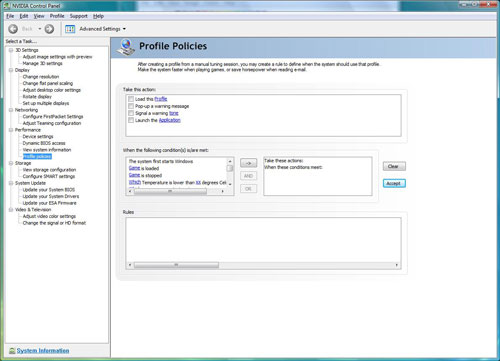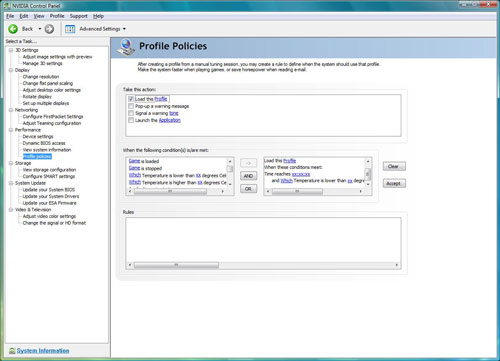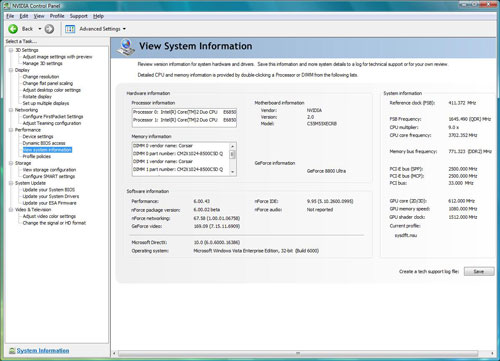The Power of Profiles
One of the most powerful and welcomed tools in the NVIDIA Control Panel is the ability to create and use profiles. Profiles are a saved set of ESA performance tweaks, a collection of rules, or a combination of both.
 |
One of the easiest ways to use profiles is to tweak all the components in the NVIDIA Control Panel to perform at the levels you choose. Then save the settings in a named profile that can be recalled at any time. For example, you could set everything for maximum system overclocking and save the profile as Max Performance. Then any time you wanted to use those settings, you choose the Max Performance profile. Similarly, you could set up a system for lowest noise and save it as a profile, or best overclocked GPU performance, or whatever system parameters you choose to enhance. With multiple saved profiles, you can then choose different sets of parameters for system control quickly and easily.
The profile feature also has powerful rule-based logic options, where you can choose certain adjustments or events to occur when other actions are started or completed. For example, this could be used to move your system to a silent profile at 12 midnight or to change overclocking capabilities when a certain demanding game is loaded. If you think of something you would like to do, the profile scripting likely has the power to accomplish that task.
 |
These are just a few examples of the potential power of profiles, but the message should be clear that profiles can provide the kind of system control that has been extremely difficult or impossible up to now. With the ability of ESA to control all the major components in a computer system, profiles will open up new ways to use and look at your computer system.
 |
The "View System Information" tab under performance is also much more powerful in an ESA box than is seen with NVIDIA Control Panel on a non-ESA system. Since ESA is capable of monitoring all the major system components, the system info is much more extensive and detailed, providing a more complete snapshot of the computer system.










19 Comments
View All Comments
cdl1701 - Friday, February 22, 2008 - link
Should there be pics in this write up? I am not seeing anyinitialised - Wednesday, February 20, 2008 - link
But using this to implement closed loop control for your overclocking and cooling setup is taking things to another level. e.g. Twc -> 1C fans -> 100RPM & Pump -> 10lph or Tcpu -> 1C Vtec -> 0.2V or more radical fps < 30 & fcore/fmem/fshader=stable, fcore/fmem/fshader -> 25MHz fan -> 10%.Most PC cooling is either crude or expensive. An OS independent control system like this with true dynamic control of BIOS CPU and Memory and GPU settings and cooling would be fantastic and could be done if crashes due to overheating/clocking can be handled before windows BSOD's. Needs a graphic (LabVIEW style) interface and low overhead though.
Hopefully it can be retrofitted to older motherboards and graphics cards with BIOS/driver updates.
Tristesse27 - Wednesday, February 20, 2008 - link
"To be fair, NVIDIA made it very clear that the current test system was put together to demonstrate the monitoring capabilities of ESA with no real finalizing of performance tweaking in ESA."Then to be perfectly fair, why would you even mention that it crashed when you try to tweak through the OS? They told you it wouldn't work, and it doesn't. I bet when the waiter tells you the plate is hot, you put your hand right on it, don't you?
stevekgoodwin - Tuesday, February 19, 2008 - link
So... turns out SMART has been subverted by various HDD manufacturers to misreport problems (because problems that might hurt sales). Which pretty much makes SMART useless.What's to stop this going the same way? There's no guarantee components are not distorting/faking results.
It'll be an interesting one to watch.
Kevin Day - Tuesday, February 19, 2008 - link
Could you imagine the kind of information you could gather on your corporate machines if someone wrote a plugin for say System Center Operations Manager? You could monitor client health not only from an applications perspective, but from the hardware as well. You could, for instance, detect a power supply that was having voltage fluctuations and replace it BEFORE it fails saving the user much down time.IKeelU - Tuesday, February 19, 2008 - link
Sorry if this has been address before, but will ESA interfaces be available for hardware that is not related to nVidia (e.g. intel chipsets, etc...)? It would be great to have a relatively consistent interface between manufacturers, similar to what a BIOS is now. If not, then I will definitely be swayed to the nVidia mobo camp. Being able to change profiles without going into the bios is going to be awesome. It's not like I need my C2D running on max overclock to use uTorrent or MS Word.Is there any chance of AMD adopting this? Does the spider platform cover most of what ESA does?
Wesley Fink - Wednesday, February 20, 2008 - link
NVidia is not charging licensing fees for ESA and the USB standard, with ESA approved to sit on top of that standard, is an Open Standard. Anyone who wishes could use ESA, and there don't appear to be unsurmountable artificial barriers to any computer manufacturer using ESA technology.LSnK - Tuesday, February 19, 2008 - link
"This begs the question of whether ESA is working now."Raises the question. Begging the question is the name of a logical fallacy wherein one assumes to be true that which they're supposed to be arguing.
Wesley Fink - Wednesday, February 20, 2008 - link
"Begs the question" expresses my thoughts.Slaimus - Tuesday, February 19, 2008 - link
Isn't there already a much more well established ESA, the Entertainment Software Association?